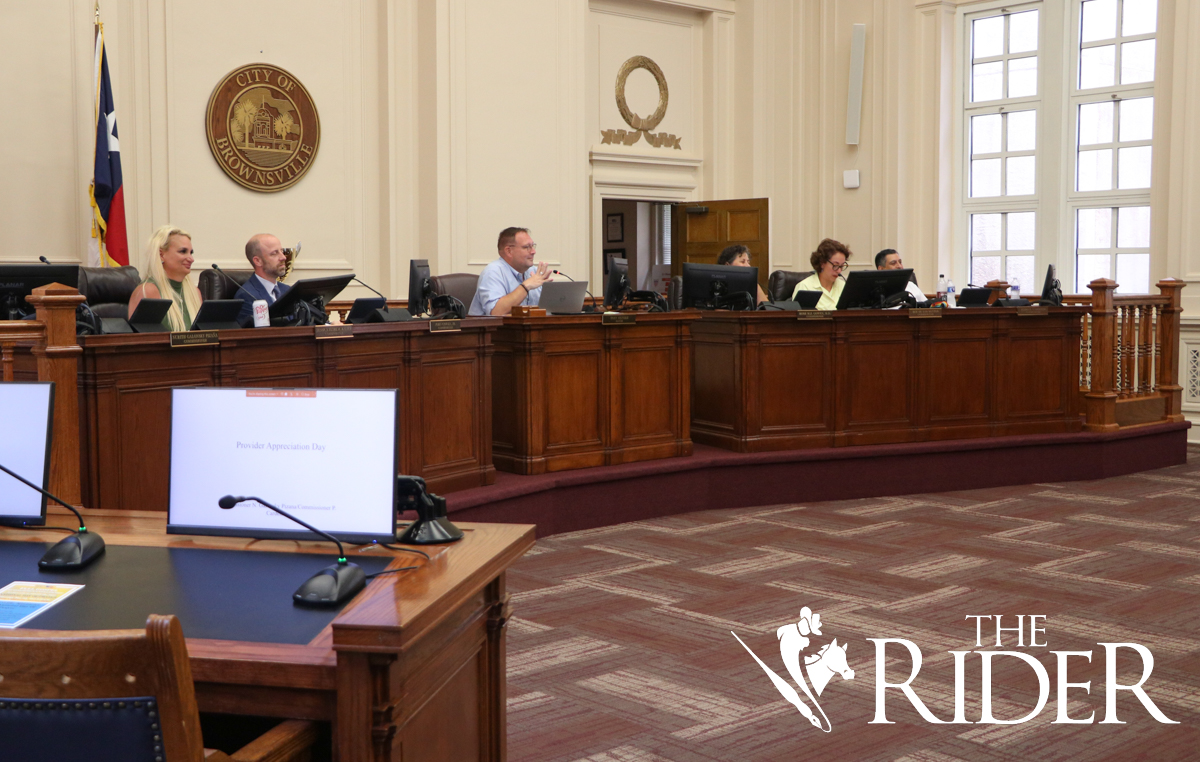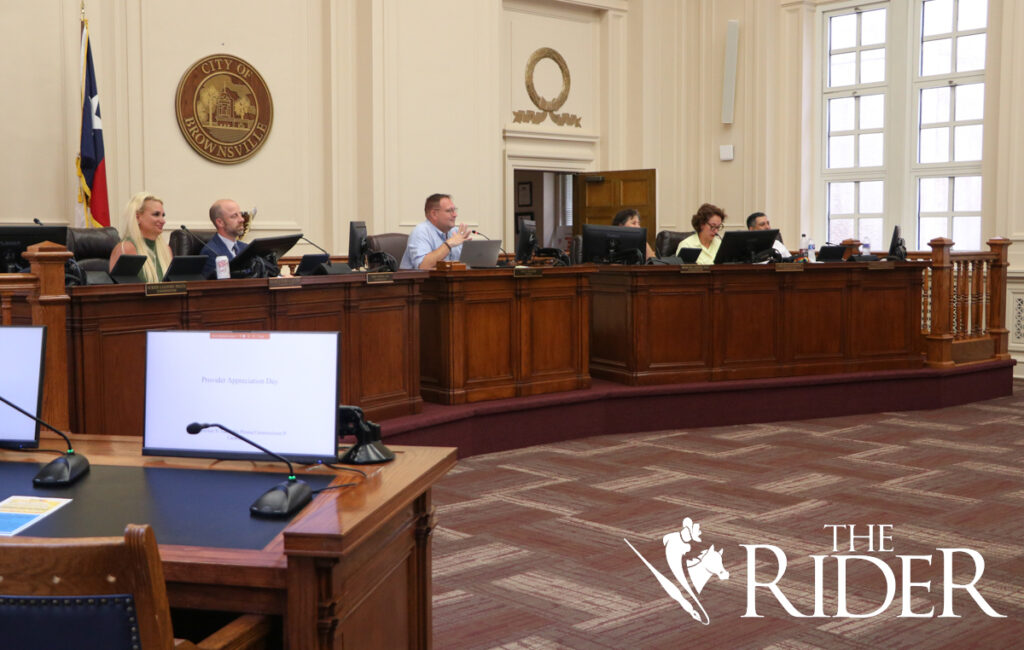
During Tuesday’s special meeting, the Brownsville City Commission approved a resolution extending the declaration of local disaster issued on April 27 by Mayor Pro Tem Nurith Galonsky Pizaña in response to the influx of migrants. The commission also discussed the city’s response to the influx and the number of people it has assisted. Members of the commission are shown during their regular meeting on May 2. Verilu Infante/THE RIDER
Mayorkas addresses Title 42 expiration in Brownsville news conference
Wednesday night, the Brownsville City Commission held a special meeting to hear concerns from residents and extend the state of emergency declaration regarding an influx of migrants into the city.
Deborah Bell was one of several residents to speak during public comment during the meeting, which was livestreamed and later uploaded to YouTube.
Bell said many of the frustrations people are voicing are “born out of a lack of transparency” from the city leaders.
“The citizens of Brownsville have every right to know what is happening in our city,” Bell said. “How many of these immigrants are staying in Brownsville? What is the plan for them when they stay? How can we ensure that you are not only protecting us, but them as well?”
Also during public comment, resident Bonnie Elbert asked the commission for transparency regarding “people crossing into [the] city illegally” and how the city’s response to the influx will affect what resources it has available.
During a work session that followed, Fire Chief Jarrett Sheldon presented an overview on the city’s response to the influx.
District 1 City Commissioner Nurith Galonksy Pizaña, acting as mayor pro tem, signed a declaration of disaster April 27.
From then through May 3, around 12,446 people crossed the Rio Grande near Fort Brown, according to Sheldon’s presentation.
The influx of migrants comes as Title 42 is about to expire.
In March 2020, in response to the COVID-19 pandemic, the Centers for Disease Control and Prevention issued the Title 42 Order to prevent the spread of the virus, according to the CDC website. The order, which suspended “the right to introduce migrants into the United States,” ends at 11:59 p.m. May 11.
Sheldon said Gloria Chavez, chief patrol agent for the El Paso Sector of the U.S. Border Patrol, requested assistance and resources from the City of Brownsville.
“We met with city leadership, myself, emergency management, Brownsville [Police Department] and city management,” he said. “… It was discussed on what resources we need to provide.”
Sheldon said part of the response approach was to first clean up the former Fort Brown Memorial golf course, which has not been used in years, and to make it a safe environment.
The city provided heavy machinery and dump trucks to bring gravel so buses can better access the area.
Other steps involved sanitizing the area, setting up canopies, clearing brush and spraying mosquito repellent as well as installing water stations, portable restrooms and trash disposal stations.
Sheldon said that existing brick-and-mortar structures at the golf course provided shelter during the recent storms and no injuries were reported.
City departments that assisted in setup include Multi-Modal Transportation and BMetro, Finance and Procurement, Organizational Development and Human Resources, the Brownsville/South Padre Island Airport, the City Secretary’s office and the City Attorney’s office.
Sheldon thanked other partners, including the Brownsville Public Utilities Board, which provided water and electricity; U.S. Customs and Border Protection; Border Patrol; police departments from Rancho Viejo, Los Indios and San Benito; the Texas Department of Public Safety, the Los Fresnos Fire Department and Cameron County.
City Manager Helen Ramirez took a moment to recognize Odee Ann Leal, emergency management director for the Office of Emergency Management & Homeland Security, and Emergency Planner Rene Tabarez Jr.
Sheldon went on to present the response from the Adams influx site, which was created so that people lacking permanent legal status released from Border Patrol do not just go to the streets.
He said Leal “has been doing an amazing job managing” the site.
“Over the past seven days, what we’re seeing are increased numbers there as well,” Sheldon said. “We were at a low for a little while, running about 100 to 200 people per day, but since April 27 or maybe a week before, it started picking up.
“So, on April 27 we did see about 526. But these past three days, we’ve been seeing 800, 900, 800. Our capacity, we’re assuming, is about 1,000 that we can process in one day. … We’re reaching that near capacity at that facility.”
A third site is the Immigrant Trending Deck, which has assisted 18,711 people since January 2023.
Sheldon said the goal is to facilitate transportation and keep people in contact with their family, who often fund transportation by buying tickets.
Different methods of transportation include charter buses as well as taxi services to the airport so people lacking permanent legal status can fly to other destinations.
District 4 City Commissioner Pedro Cardenas asked how many people were still in need of transportation and what comes next.
“The estimated time that they spend at [the Fort Brown] facility is about three hours,” Sheldon replied. “… There was approximately 2,500 to 2,600. … They were able to transport most of them out in the late morning hours.
“What’s next is we are going to stay in close communication with them and really adapt to what resources we need.”
During a televised news conference today in Brownsville, Homeland Security Secretary Alejandro Mayorkas said authorities “will deliver consequences for individuals who arrive at [the] southern border irregularly.”
“That is our obligation as a way of cutting the smugglers out and taking care of the safety and needs of individuals who qualify for relief,” Mayorkas said. “In a post-Title 42 environment, we will be using our expedited removal authorities under Title 8 of the United States code.”
He said smugglers are spreading misinformation to exploit vulnerable people who are thinking of migrating.
“Do not believe the smugglers,” Mayorkas said. “Please access the official government publications. Please access the official government information on the Department of Homeland Security website for accurate information because you are being deceived and you are risking your lives and your life savings only to meet a consequence that you do not expect at our southern border.”

Verilu Infante/THE RIDER





